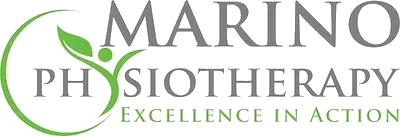Balance And Gait Center In Knoxville
The Balance And Gait Center At Marino Physiotherapy In Knoxville
Stop by to check out our state-of-the-art Balance and Gait Center! The Marino Balance and Gait Center is equipped with the latest in specialized equipment designed to help patients improve their balance, gait, and overall mobility. Specifically, our Balance and Gait Center offers:
Thank you for reading this post, don't forget to subscribe!- Unweighted Gait and Balance System
- Super Low Speed Treadmill with high variability incline
- Ramp and Stairs
- Vestibular First Video Goggles for Dizziness and Vertigo
- BlazePods Reactivity and Coordination System
- PneuMap Posture Mapping and PneuMex Posture Chair
- Wii Balance Board
- Balance and Agility Training Tools including Boards, Balls, Obstacles, and Ladder
- Options to incorporate Aquatic Rehab into training
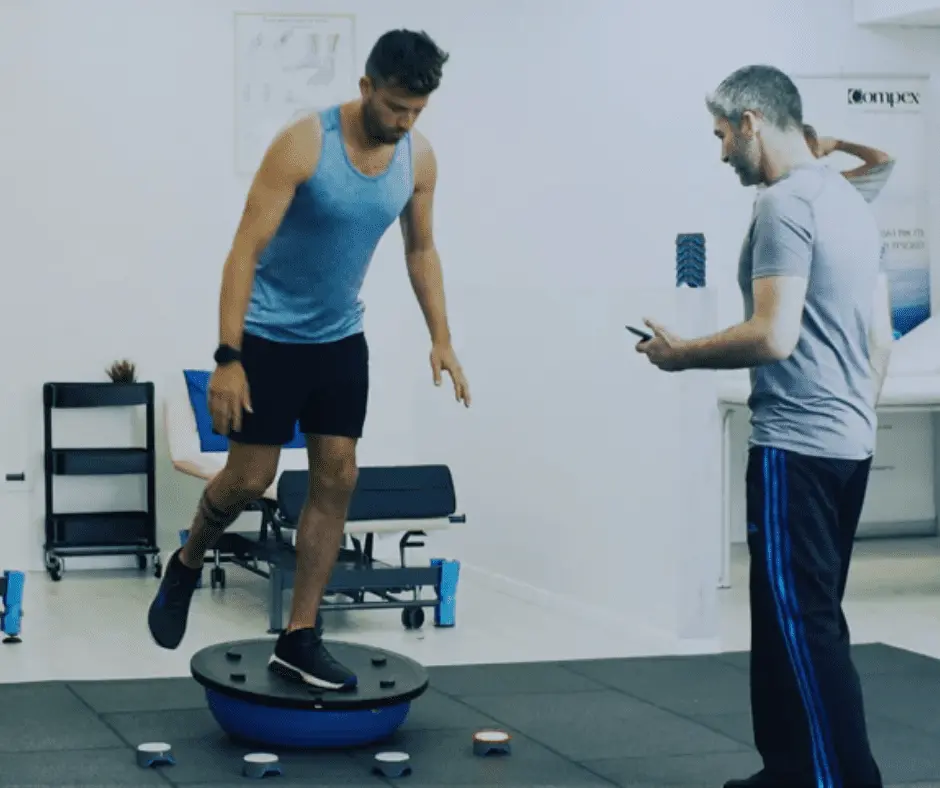
READY TO START FEELING AND MOVING BETTER?
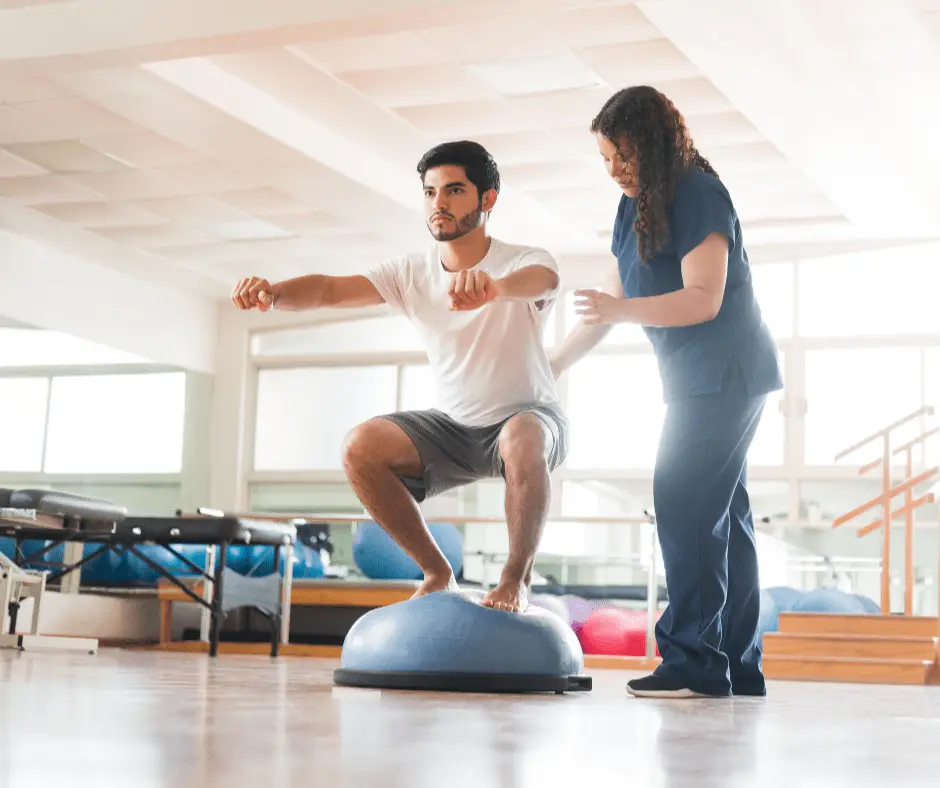
Our expert staff is the highest credentialed team in the region and we have advanced training in hands-on care to help your body move and feel better, as well as the latest equipment to support your rehab training. Our PT specialists are specially trained in the evaluation and treatment of patients with balance and gait disorders. These therapists have expertise in developing individualized treatment plans that address the unique needs of each patient, and are skilled in providing hands-on guidance and support to help patients achieve their goals.
The Marino Physiotherapy Balance and Gait center takes a comprehensive approach to treatment, addressing not only the physical impairments that affect balance and gait, but also incorporating strategies to mitigate underlying secondary factors that contribute to these impairments. This can include factors such as postural and musculoskeletal dysfunction, cognitive deficits, medication side effects, and environmental barriers, and involves working closely with other healthcare providers to ensure that patients receive the total care they need. Here at Marino Physiotherapy, we take a patient-centered care approach, focusing on the unique needs and goals of each individual patient. This involves working closely with patients and their families to develop treatment plans that are tailored to meet their specific needs.
Patients who participate in our balance and gait program can experience significant improvements in their functional abilities, including increased balance, gait speed, and endurance. This can lead to increased independence, improved quality of life, and reduced risk of falls and other injuries.
The Marino Physiotherapy Balance and Gait Center and our skilled team of therapists are here to help with all types of balance and gait disorders, helping patients to improve their functional abilities, reduce their risk of falls and injuries, and improve their overall quality of life.
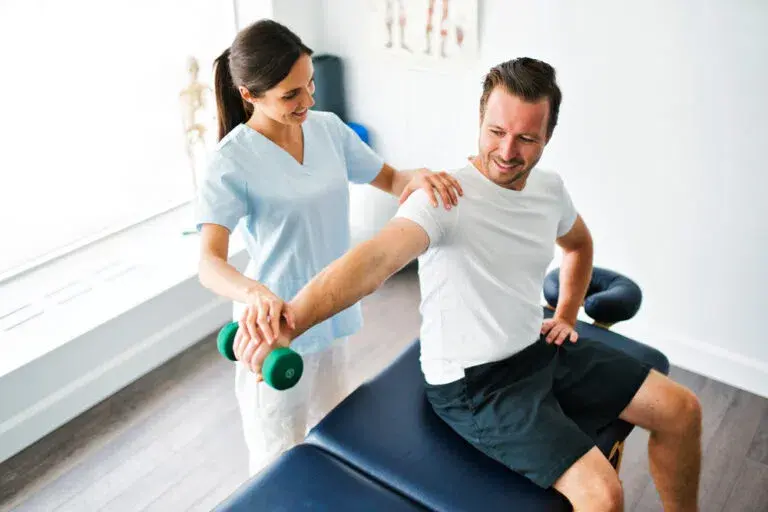
Check Out Some Of The Cool Features Offered At The Marino Physiotherapy Balance and Gait Center In Knoxville
Unweighted Gait System
Unweighted gait training, also known as partial weight-bearing gait training, is a rehabilitation technique that involves reducing the amount of weight that is placed on the spine and lower extremities during walking or standing. This technique has several potential benefits, including:
- Reduced stress on joints: By reducing the amount of weight bearing through the spine and lower extremities, unweighted gait training can help to reduce the stress on the joints, which may be beneficial for individuals with arthritis or other joint-related conditions.
- Improved balance and coordination: Unweighted gait training can help to improve balance and coordination by allowing individuals to focus on their movements without the added stress of supporting their full body weight of worrying about a loss of balance / fall risk.
- Increased mobility: By reducing the weight placed on the spine and lower extremities, unweighted gait training can help to increase mobility and range of motion, which may be especially helpful for individuals with functional impairments.
- Improved Safety and Reduced risk of falls: Individuals who have a high risk of falls may benefit from unweighted gait training, as it can help to improve balance and coordination, which can, in turn, reduce the risk of falls.
- Improved cardiovascular fitness: Unweighted gait training can also help to improve cardiovascular fitness by allowing individuals to perform more intensive exercises without the added weight-bearing stress on the joints.
Overall, unweighted gait training can be a beneficial rehabilitation technique for a wide range of individuals, and may help to improve mobility, balance, coordination, and overall fitness.
Blazepods
BlazePods are a versatile training tool that can be used in a variety of settings, including physical therapy. They are a portable, interactive, and high-intensity training system that utilizes visual cues and sensory stimulation to enhance cognitive and motor skills. Here are some of the benefits of using BlazePods for physical therapy:
- Improved coordination: BlazePods can help to improve coordination by providing visual cues that require precise movements to be executed. This can help to train the brain to better coordinate the movements of the limbs.
- Improved reaction time: BlazePods can help to improve reaction time by requiring individuals to react quickly to visual stimuli. This can help to improve coordination of motion at speed in dynamic activities.
- Enhanced balance: BlazePods can help to improve balance by challenging individuals to maintain their balance while performing various exercises. This can help to improve stability and prevent falls.
- Increased cardiovascular fitness: BlazePods can be used for high-intensity interval training (HIIT) workouts, which can help to improve cardiovascular fitness and overall endurance. This is especially helpful for a variety of cardiovascular issues such as POTS, coronary artery disease, hypertension, metabolic syndrome, and peripheral artery disease.
- Fun and engaging: BlazePods are an interactive and engaging training tool that can help to motivate individuals to participate in physical therapy exercises. This can help to improve compliance and overall satisfaction with the therapy process.
BlazePods are an effective and versatile tool for improving coordination, reaction time, balance, cardiovascular fitness, and overall engagement in the therapy process.
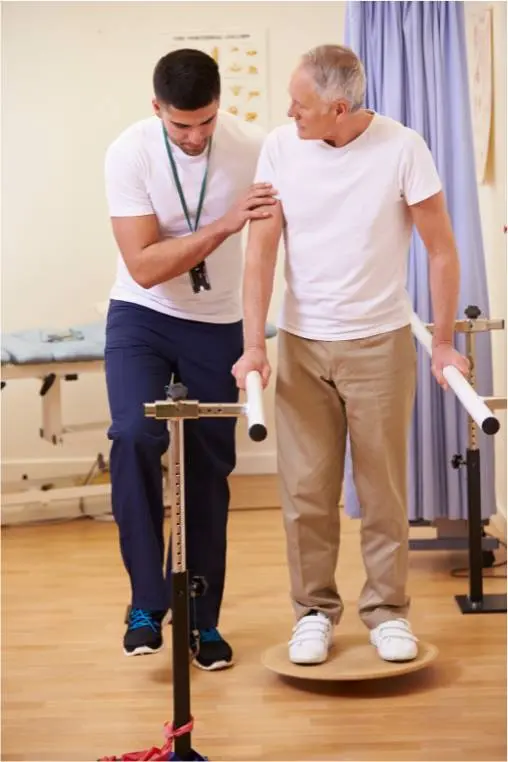
READY TO START FEELING AND MOVING BETTER WITH OUR BALANCE & GAIT CENTER?
Wii Balance Board
The Wii Balance Board is a video game accessory that can be used in physical therapy to help individuals improve their balance and coordination, proprioception, and motivation. Here are some of the benefits of using the Wii Balance Board for physical therapy:
- Improved balance: The Wii Balance Board provides real-time feedback on an individual’s balance, which can help to improve balance control and stability, as well as establishing baseline and progress scores that are helpful in justifying needed care to insurance companies.
- Increased coordination: The Wii Balance Board can be used to improve coordination by requiring individuals to move their body in response to on-screen prompts.
- Enhanced proprioception: Proprioception refers to an individual’s awareness of their body position and movement. The Wii Balance Board can help to improve proprioception by requiring individuals to make small adjustments to maintain balance.
- Increased motivation: The Wii Balance Board can make physical therapy exercises more engaging and fun, which can help to increase motivation and compliance with the therapy program.
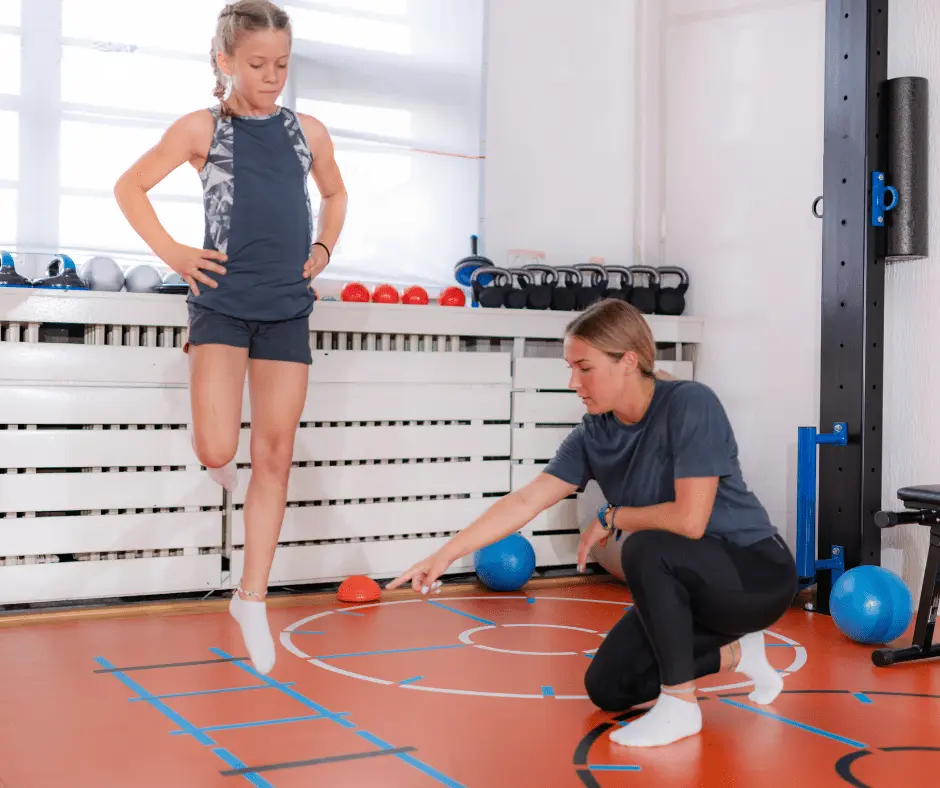
READY TO START FEELING AND MOVING BETTER?
Vestibular First Goggles
Vestibular goggles are a type of specialized eyewear that can be used in physical therapy to assess and track an individual’s vestibular function. The goggles contain sensors that track eye movements and provide feedback to the individual through visual stimuli. Here are some of the benefits of using vestibular goggles in physical therapy:
- Improved balance: Vestibular goggles can be used to improve balance by providing real-time feedback on an individual’s head movements, which can help to improve balance control and stability.
- Enhanced vestibular function: The vestibular system is responsible for detecting movement and maintaining balance. Vestibular goggles can help to enhance the function of the vestibular system by providing visual feedback that can direct interventions to improve the brain’s ability to process sensory information.
- Reduced risk of falls: Vestibular goggles can help to reduce the risk of falls by more precisely identifying causes of poor balance and coordination.
- Increased motivation: The use of vestibular goggles can make physical therapy more engaging as the patient can clearly visualize the underlying issue behind the dizziness -, which can help to increase motivation and compliance with the therapy program.
- Personalized therapy: Vestibular goggles can help in identifying an individual’s specific needs and can be used to customize a targeted plan to address the patient’s specific areas of balance and vestibular function.
Vestibular goggles and video recording are the keys to advanced-level assessment and are effective assessment tools for physical therapy, helping to improve balance, vestibular function, reduce the risk of falls, increase motivation, and provide personalized therapy.
Whole Body Vibration
Whole body vibration (WBV) is a type of therapy that involves the use of a vibrating platform to stimulate the muscles and bones throughout the body. Here are some of the benefits of using whole-body vibration in physical therapy:
- Improved bone density: Whole body vibration has been shown to help increase bone density in individuals with osteoporosis, which can help to reduce the risk of fractures.
- Improved muscle strength: The vibrations from the platform can help to recruit muscle fibers, which can lead to an increase in muscle strength and power.
- Increased flexibility: Whole body vibration can help to improve flexibility by increasing blood flow to the muscles and reducing muscle tension.
- Enhanced proprioception: Whole body vibration can help to improve proprioception by stimulating the receptors in the muscles and joints that are responsible for detecting changes in body position and movement.
- Improved balance and stability: Whole body vibration can help to improve balance and stability by stimulating the muscles and nerves that are responsible for maintaining balance.
- Increased circulation: The vibrations from the platform can help to increase blood flow and circulation, which can aid in the healing process and reduce inflammation.
Overall, whole-body vibration can be an effective therapy for a variety of conditions, helping to improve bone density, muscle strength, flexibility, proprioception, balance and stability, and circulation. However, it is important to consult with a healthcare professional before starting whole-body vibration therapy, as it may not be suitable for everyone.
The “Car Wash”
Want to have a little fun while improving your balance? Check out our “Car Wash” where you get to navigate uneven surfaces (like walking in a bumpy yard) while bobbing and dodging overhead obstacles (made of foam balls and fun noodles). Walking on uneven surfaces is a common technique used in physical therapy to improve balance and coordination. Here are some of the benefits of walking on uneven surfaces in physical therapy:
- Improved balance: Walking on uneven surfaces requires individuals to make constant adjustments to their body position, which can help to improve balance and stability.
- Increased proprioception: Proprioception refers to an individual’s awareness of their body position and movement. Walking on uneven surfaces can help to improve proprioception by requiring individuals to make small adjustments to maintain balance.
- Improved coordination: Walking on uneven surfaces can help to improve coordination by requiring individuals to use multiple muscle groups and maintain control of their body movements.
- Enhanced muscle strength: Walking on uneven surfaces can help to strengthen the muscles in the legs, ankles, and feet, which can improve overall stability and balance.
- Reduced risk of falls: Walking on uneven surfaces can help to reduce the risk of falls by improving balance and coordination, which are essential for maintaining an upright posture and avoiding accidents.
Overall, walking on uneven surfaces can be an effective and simple way to improve balance and coordination in physical therapy, helping to enhance proprioception, coordination, muscle strength, and reduce the risk of falls. It is important to work with a physical therapist to ensure that the technique is performed safely and effectively.
Posture Mapping
Posture mapping is a technique used in physical therapy to assess an individual’s posture and identify areas of imbalance or dysfunction. Posture mapping involves the use of tracing the spine along a grid, and the digital analysis of individual’s body position and movement patterns. Posture and balance are closely related, and poor posture can negatively impact balance. Here are some ways that posture affects balance:
- Alignment: Proper alignment of the body is important for maintaining balance. When the body is not aligned correctly or is leaning, it can be more difficult to maintain balance.
- Muscle activation: Good posture requires the activation of specific muscles throughout the body. These muscles are responsible for maintaining proper alignment and balance.
- Proprioception: Proprioception refers to an individual’s awareness of their body position and movement. Poor posture can impair proprioception, making it more difficult to recognize the center of gravity and maintain balance.
- Center of gravity: The center of gravity is the point in the body where the weight is evenly distributed. Good posture helps to maintain a stable center of gravity, which is important for maintaining balance.
- Joint mobility: Poor posture can lead to joint stiffness and limited mobility, which can affect balance and stability. Thank goodness the Marino Physio’s have advanced hands on training to help get your joints and tissues moving better and more comfortably!
Overall, good posture is essential for maintaining balance. By promoting proper alignment, muscle activation, proprioception, center of gravity, and joint mobility, good posture can help to improve balance and reduce the risk of falls. It is important to work with a physical therapist to improve posture and balance through exercises and other interventions.
Parallel Bars
Parallel bars are a common piece of equipment used in physical therapy rehab settings to help patients with mobility and gait impairments. Here are some ways in which parallel bars can help in rehab:
- Support and stability: Parallel bars provide patients with a stable support system to hold onto while they practice walking and other weight-bearing exercises. This can help patients feel more confident and secure as they work on regaining their mobility and balance.
- Gait training: Physical therapists can use parallel bars to help patients practice their gait, or walking pattern. Patients can start by holding onto the bars and taking small steps, gradually increasing their speed and distance as they become more comfortable and confident. Therapists can also use the bars to help patients work on specific aspects of their gait, such as heel strike or toe-off.
- Strengthening and range of motion exercises: Parallel bars can be used to perform a variety of strengthening and range of motion exercises, such as squats, lunges, and leg swings. These exercises can help patients improve their muscle strength, flexibility, and overall mobility.
- Balance training: Parallel bars can be used to perform balance exercises, such as standing on one foot while holding onto the bars for support. These exercises can help patients improve their balance and stability, reducing their risk of falls and other injuries.
- Progression and challenge: As patients progress in their rehab, parallel bars can be used to provide increasing levels of challenge and difficulty. For example, patients can practice walking backwards or sideways along the bars, or perform exercises with one hand on the bar and one hand off. We can combine the parallel bars with the Unweighted Gait system for even more assistance and security.
Overall, parallel bars are a versatile and useful tool in physical therapy rehab, providing patients with support, stability, and a safe environment in which to practice and advance their mobility and gait skills.
Balance And Agility Training Tools
A BAPS board is a balance training device that is commonly used in physical therapy to improve balance and coordination. BAPS stands for “Biomechanical Ankle Platform System.” The device consists of a circular board that is mounted on a hemispherical base. We also use a variety of other unstable surfaces such as wobble boards,BOSU balls, stability balls, stepping stones, and foam pads. These are designed to be unstable, which challenges the user to maintain balance and stability while performing exercises.
- Improved proprioception: The unstable surface of the BAPS board requires the user to make constant adjustments to maintain balance. This helps to improve proprioception, which is the body’s ability to sense its position in space.
- Increased muscle activation: Using an unstable surface in rehab training requires the activation of multiple muscle groups throughout the body, particularly in the legs and core. This can help to improve overall muscle strength and balance.
- Enhanced coordination: A BAPS board requires the user to coordinate movements of the legs, core, and upper body to maintain balance. This can help to improve overall coordination and motor control.
- Rehabilitation of ankle, knee, and hip injuries: These tools can be particularly effective in the rehabilitation of lower quarter injuries. By challenging the joints to maintain stability on an unstable surface, the device can help to improve strength, range of motion, coordination, proprioception, and dynamic control and stability.
Overall, these tools are effective for improving balance and coordination in physical therapy. By challenging proprioception, muscle activation, coordination, and ankle rehabilitation, training on an unsteady surface board can help to improve overall balance and reduce the risk of falls.
It is important to work with a physical therapist to ensure that the technique is performed correctly, safely, and effectively.
Agility training is a type of physical therapy that focuses on improving an individual’s ability to move quickly and easily while maintaining balance and control. Agility training typically involves exercises that require quick changes of direction, acceleration, and deceleration, often incorporating equipment such as cones, agility ladders, and hurdles, all of which are available in Marino Physiotherapy’s Balance and Gait Center! Here are some ways that agility training can improve balance in physical therapy:
- Improved proprioception: Agility training requires the individual to move quickly and change direction frequently, which can help to improve proprioception. This is the body’s ability to sense its position in space, and it is essential for maintaining balance.
- Enhanced coordination: Agility training requires the individual to coordinate movements of the legs, core, and upper body while moving quickly and changing direction. This can help to improve overall coordination and motor control, which can improve balance.
- Increased muscle strength: Agility training involves exercises that require the use of multiple muscle groups throughout the body, particularly in the legs and core. This can help to improve overall muscle strength and balance.
- Improved reaction time: Agility training requires the individual to respond quickly to visual or auditory cues, which can help to improve reaction time. This is important for maintaining balance and avoiding falls.
Overall, agility training can be an effective way to improve balance in physical therapy. By promoting proprioception, coordination, muscle strength, and reaction time, agility training can help to improve overall balance, increase dynamic stability, and reduce the risk of falls. It is important to work with a physical therapist to ensure that the technique is performed safely and effectively.
The Balance and Gait Center at Marino Physiotherapy is your one stop shop for the latest and greatest in balance and stability training. We work WITH you to get you back in action or even better than before as you get back to your favorite activities; everything from gardening to soccer and more. Call or Text (865) 236-0340 today to get in for an assessment and the best training in the area!
